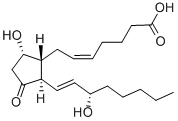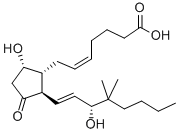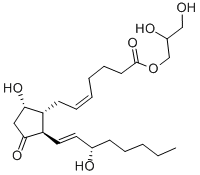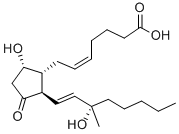PROSTAGLANDIN D2
Synonym(s):PGD2;PGDS;prostaglandin D2 synthase (brain);(5Z,9α,13E,15S)-9,15-Dihydroxy-11-oxoprosta-5,13-dien-1-oic-acid;L-PGDS
- CAS NO.:41598-07-6
- Empirical Formula: C20H32O5
- Molecular Weight: 352.47
- MDL number: MFCD00077857
- EINECS: 636-995-9
- SAFETY DATA SHEET (SDS)
- Update Date: 2024-11-19 20:33:22

What is PROSTAGLANDIN D2?
Description
Prostaglandin D2 (PGD2) is the major eicosanoid product of mast cells and is released in large quantities during allergic and asthmatic anaphylaxis. Mastocytosis patients produce excessive amounts of PGD2, which causes vasodilation, flushing, hypotension, and syncopal episodes. PGD2 is also produced in the brain via an alternative pathway involving a soluble, secreted PGD-
The Uses of PROSTAGLANDIN D2
Prostaglandin D2 is a fatty acid compound present in the human body. Elevated levels of localized Prostaglandin D2 has been linked to hair loss and growth inhibition. It has also been seen to contribute to the activity of allergic asthma.
What are the applications of Application
PGD2 (Prostaglandin D2) is a major regulator shown to bind DP and CRTH2 receptors that inhibits platelet aggregation
Definition
ChEBI: A member of the class of prostaglandins D that is prosta-5,13-dien-1-oic acid substituted by hydroxy groups at positions 9 and 15 and an oxo group at position 11 (the 5Z,9alpha,13E,15S- s ereoisomer).
Biochem/physiol Actions
Primary prostaglandin in brain; induces inflammation; stimulates adenylyl cyclase.
Properties of PROSTAGLANDIN D2
| Melting point: | 68°C |
| Boiling point: | 406.07°C (rough estimate) |
| alpha | +7.5°(D/21℃)(c=1,THF) |
| Density | 1.0601 (rough estimate) |
| refractive index | 1.6120 (estimate) |
| storage temp. | -20°C |
| solubility | Chloroform (Slightly), Ethanol (Slightly), Methanol (Slightly), THF (Slightly) |
| form | White solid |
| pka | 4.76±0.10(Predicted) |
| color | White to Light Orange |
| BRN | 2170623 |
| Stability: | Light Sensitive |
Safety information for PROSTAGLANDIN D2
| Signal word | Danger |
| Pictogram(s) |
 Exclamation Mark Irritant GHS07  Health Hazard GHS08 |
| GHS Hazard Statements |
H302:Acute toxicity,oral H360:Reproductive toxicity |
| Precautionary Statement Codes |
P201:Obtain special instructions before use. P308+P313:IF exposed or concerned: Get medical advice/attention. |
Computed Descriptors for PROSTAGLANDIN D2
New Products
Tert-butyl bis(2-chloroethyl)carbamate (S)-3-Aminobutanenitrile hydrochloride N-Boc-D-alaninol N-BOC-D/L-ALANINOL 3-(2,4-Dimethoxybenzyl)dihydropyrimidine-2,4(1H,3H)-dione 7-Bromo-1H-indazole N-octanoyl benzotriazole 3,4-Dibenzyloxybenzaldehyde 4-Hydrazinobenzoic acid Electrolytic Iron Powder Fmoc-Val-Cit-PAB 1,1’-CARBONYLDIIMIDAZOLE R-2-BENZYLOXY PROPIONIC ACID 4-HYDROXY BENZYL ALCOHOL 1,1’-CARBONYLDI (1,2-4 TRIAZOLE) S-2-CHLORO PROPIONIC ACID (2-Hydroxyphenyl)acetonitrile 4-Bromopyrazole 5-BROMO-2CYANO PYRIDINE 5,6-Dimethoxyindanone 5-broMo-2-chloro-N-cyclopentylpyriMidin-4-aMine 1-(4-Methylphenylsulfonyl)-1H-1,2,3-benzotriazole 1-(2-Chlorobenzyl)-4-nitro-1H-pyrazole 1-(2-Nitrophenyl)-4-phenylpiperazineRelated products of tetrahydrofuran
![[5,6,8,9,12,14,15(N)-3H]-PROSTAGLANDIN D2](https://img.chemicalbook.in/StructureFile/ChemBookStructure2/GIF/CB4135874.gif)
![PGD2 [1-14C]](https://img.chemicalbook.in/StructureFile/ChemBookStructure8/GIF/CB2331845.gif)






You may like
-
 Prostaglandin D2 CAS 41598-07-6View Details
Prostaglandin D2 CAS 41598-07-6View Details
41598-07-6 -
 Prostaglandin D2 CAS 41598-07-6View Details
Prostaglandin D2 CAS 41598-07-6View Details
41598-07-6 -
 Ste-Glu-AEEA-AEEA-OSUView Details
Ste-Glu-AEEA-AEEA-OSUView Details
1169630-40-3 -
 1446013-08-6 Fmoc-His-Aib-OH TFA 98%View Details
1446013-08-6 Fmoc-His-Aib-OH TFA 98%View Details
1446013-08-6 -
 127464-43-1 99%View Details
127464-43-1 99%View Details
127464-43-1 -
 Chloro Uracil 99%View Details
Chloro Uracil 99%View Details
1820-81-1 -
 2-ETHYLPYRIDINE 100-71-0 99%View Details
2-ETHYLPYRIDINE 100-71-0 99%View Details
100-71-0 -
 13162-05-5 99%View Details
13162-05-5 99%View Details
13162-05-5